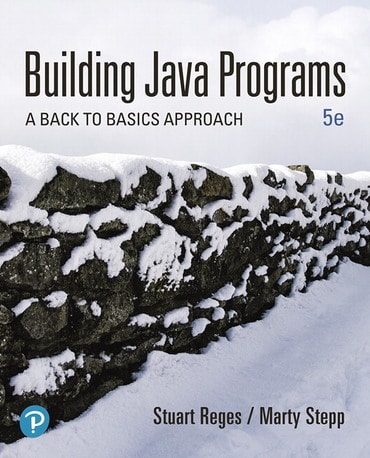
Building Java Programs: A Back to Basics Approach, 5th edition
- Stuart Reges |
- Marty Stepp |
Title overview
For courses in Java programming.
Effective step-by-step Java education
Building Java Programs introduces new concepts and syntax using a spiral approach, ensuring students are thoroughly prepared as they work through CS1 material. Through the first 4 editions, Building Java Programs and its back-to-basics approach have proven remarkably effective.
The 5th Edition has been extensively updated with incorporation of JShell integration, improved loop coverage, rewritten and revised case studies, examples, updated collection syntax and idioms, expanded self-check and programming exercising sections, and new programming projects.
Hallmark features of this title
- Sections added to Chapter 2 help students understand loops and how to create effective tables for discovering patterns in nested loops.
- Self-check problems and programming exercises have been added to every chapter, and others have been updated or revised.
- JShell information has been included in Chapter 2, bringing the text up to date with the latest version of Java.
- Programming projects have been added to some chapters, including a ranked choice ballot project in Chapter 10.
New and updated features of this title
- UPDATED: Various sections throughout the text, including examples, have been rewritten to incorporate feedback from both students and instructors.
- UPDATED: The Chapter 10 case study has been rewritten to feature a new program about elections and ranked choice voting.
- UPDATED: Chapters 10 and 11 have been updated to include new syntax and features that have been introduced in new Java releases.
Table of contents
- Introduction to Java Programming
- Primitive Data and Definite Loops
- Introduction to Parameters and Objects
- Supplement 3G. Graphics (Optional)
- Conditional Execution
- Program Logic and Indefinite Loops
- File Processing
- Arrays
- Classes
- Inheritance and Interfaces
- ArrayLists
- Java Collections Framework
- Recursion
- Searching and Sorting
- Stacks and Queues
- Implementing a Collection of Class
- Linked Lists
- Binary Trees
- Advanced Data Structures
- Functional Programming with Java 8
APPENDICES
- A. Java Summary
- B. The Java API Specification and Javadoc Comments
- C. Additional Java Syntax
Author bios
About our authors
Stuart Reges is a Principal Lecturer in the Paul G. Allen School of Computer Science and Engineering at the University of Washington. He manages the introductory programming classes, participates in the design of undergraduate curricula and is involved in K to 12 outreach. He held similar positions at Stanford University and the University of Arizona in a career spanning 30 years. In 1985 he won the Dinkelspiel Award for Outstanding Service to Undergraduate Education at Stanford. In 2012 he won the Distinguished Teaching Award which is the highest award given by UW for teaching.
Marty Stepp is a computer science lecturer at the University of Washington where he teaches intro programming, web programming and software engineering. Google highlighted his web programming resources in their Google Code for Educators initiative, and he was featured as the Seattle PI's “Geek of the Week.” Stepp is the lead author of Web Programming Step by Step, with Jessica Miller and Victoria Kirst from the University of Washington. He is also coauthor of Building Java Programs: A Back to Basics Approach with Stuart Reges. Stepp wrote an online tool for practicing Java problems to accompany the Java textbook, called Practice-It!. He is also first author of Computing Fundamentals with C#.
From 2004 to 2006, Stepp worked as a computer science lecturer at the University of Washington, Tacoma. Before that he spent a year as a developer at Microsoft on the Excel team. Stepp got a master's degree in computer science at the University of Arizona in 2003. He has done research in geometric algorithms and security, taught several courses as a graduate student and was a teaching assistant for several years.